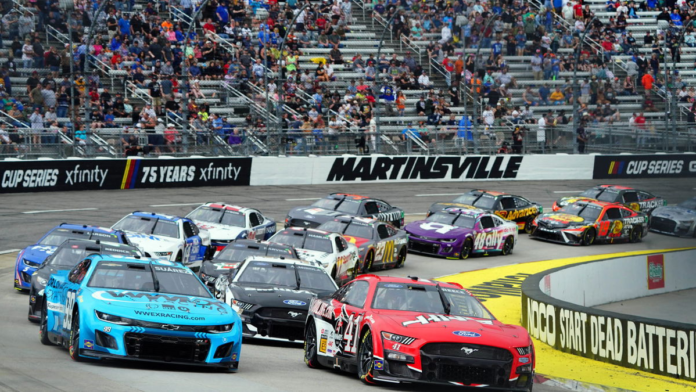If you’ve been a NASCAR fan for a while, you probably remember the days when the cars looked like actual works of art. Take, for example, Dale Earnhardt Jr.’s famous red-and-white Budweiser Chevy or Jeff Gordon’s iconic flame-splattered Dupont car. These schemes weren’t just designs—they were reflections of the personalities and sponsorships that helped shape NASCAR’s identity during the early days. But what made these cars even more impressive was the craftsmanship that went into their paint jobs.
For decades, NASCAR cars have been an iconic part of the sport, and one of the most notable aspects of these high-speed machines is their paint schemes. From bold, eye-catching designs to sponsors’ logos plastered all over, the evolution of NASCAR paint jobs has mirrored changes in technology, aesthetics, and efficiency. Joe Gibbs Racing recently took fans on a journey through this transformation, showing how NASCAR’s paint schemes evolved from hand-painted masterpieces by legendary NASCAR artists like Sam Bass to the vinyl wraps seen today.
The hand-painted era: a true labor of love
ADVERTISEMENT Article continues below this ad
Back in the early days of NASCAR, every car that raced was hand-painted. These cars were not factory-finished machines with decals slapped on top. The teams had to put in hours of work to give each car its vibrant colors and designs. First, a base coat was applied, then decals were placed carefully over the body. Afterward, the car would be sanded down to make sure the decals adhered properly, before being topped off with a clear coat to smooth out the edges.
This process wasn’t just time-consuming; it was meticulous. Teams worked tirelessly to make sure every detail was perfect, and it was often a huge part of the car’s appeal to fans. If you ever watched a race in person, you knew that the paint jobs were as much of a spectacle as the race itself. The colors gleamed under the track lights, and the cars were a visual feast. If you were watching on TV, the colors were vivid and sharp, thanks to the advances in broadcasting technology at the time. For many fans, these hand-painted cars were the very definition of NASCAR.
Joe Gibbs Racing posted an insightful video on Instagram that laid out the evolution of these paint jobs. “Race cars don’t need headlights because the track is always lit. They are just stickers, and so is the rest of the car,” the video begins, showing how cars were initially painted using hand brushes, with just a few decals added for flair.
The JGR video continued, “In 1959, while painting a recently repaired car, a team mixed two different cans of paint together since neither can had enough to paint the whole car.” This approach led to the creation of one of NASCAR’s most iconic custom schemes: ‘Petty Blue,’ which was famously used by Richard Petty’s car. The King sharing the story had said, “We had some blue paint and some white paint; not enough of either for the whole car. But we had enough so if we mixed them, we could paint the whole car one color.”
In one memorable moment, Dale Earnhardt Jr. was captured in a hilarious video where he couldn’t stop marveling at the work that went into these paint jobs. In his own way, he captured the essence of what it meant to be a part of that hand-painting tradition. “They sand it and clear coat it,” he repeated breathlessly, emphasizing just how much care and effort went into the creation of those stunning designs.
View this post on Instagram A post shared by Joe Gibbs Racing (@joegibbsracing)
But as time went on, custom paint jobs became more common, especially after 1967, when teams started experimenting with different designs and colors. By 1997, however, something began to change in a major way. A team wanted to create a chrome finish, and in order to achieve it, they decided to wrap the entire car instead of painting it. This experiment not only worked—it made a lot of sense. By the mid-2000s, NASCAR began to see a shift. As the sport grew and the demands on teams became even greater, convenience and efficiency began to take center stage. Enter the vinyl wrap. Wrapping a car with vinyl sheets took hours, not days. And the best part? It was much lighter than the heavy layers of paint and clear coat, improving the car’s performance.
While veteran NASCAR fans might not like the shift, vinyl just took over!
Why did vinyl become the future of NASCAR?
Trending
The video further talks about how by 2007, about half of the cars on the track were fully wrapped in vinyl, and by 2014, painted cars were a rarity. While many race shops still had paint booths, they were mostly being repurposed, as every car on the track was now wrapped in high-quality vinyl sheets. These vinyl wraps allowed for more intricate designs, easier maintenance, and faster turnaround times.
ADVERTISEMENT Article continues below this ad
While the days of hand-painted masterpieces may seem like a thing of the past, the switch to vinyl wraps didn’t just happen for practical reasons—it allowed teams to get more creative. Wraps offered the opportunity to experiment with bold new looks that could be easily adjusted and replaced between races. Plus, they were far more cost-effective, cutting down on the time, effort, and expense that came with hand-painting a car from scratch.
via Imago Kyle Busch and Kyle Larson’s paint schemes, both are vinyl wraps
Today, if you walk into any race shop, you’ll notice that the once-thriving paint booths have been replaced by cutting-edge wrapping technology. The result is a stunning new era of NASCAR designs that may not have the same craftsmanship as those hand-painted classics, but they’ve certainly captured the spirit of the sport.
ADVERTISEMENT Article continues below this ad
Thanks to the JGR video, we took a walk down memory lane to look back through NASCAR’s colorful history, showing us just how much the sport—and its iconic cars—have evolved over the years. Whether it’s the artful brushstrokes of a hand-painted job or the sleek precision of a vinyl wrap, the spirit of NASCAR will always be in the paint schemes of the cars. Which have been some of your favorite paint schemes? Share your thoughts with us in the comments down below.


